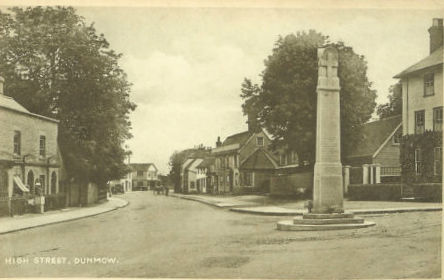Remembrance: The World War One Memorials of Great Dunmow
I am delighted to be able to tell you that fellow local historian of Great Dunmow, Austin Reeve, has just published his book Remembrance: The World War One Memorials of Great Dunmow.
Austin has meticulously researched some of the men commemorated on the war memorials in and around Great Dunmow and recounted some of their tragic stories. He has also gathered together a unique collection of photographs and memorabilia (such as postcards, medals, certificates and – most extraordinary – a battlefield will) from the families of the town’s fallen and combined it all into a compelling book.
If you are interested in the local history of Great Dunmow (a small town in North West Essex), or indeed, the fallen of the First World War, I would highly recommend this book to you.

I must admit to getting goose-bumps when I saw the front cover as I know my granddad and my grandmother were likely to have been in the crowd, and also possibly my great-grandparents – the two Kemp brothers commemorated on the memorial being my granddad’s cousins (my great-grandmother’s nephews).
If you wish to purchase this book for the highly reasonable price of £5 (inc p&p to the UK), please email Austin Reeve directly at ashble55[at}yahoo.com. Austin’s book is proving to be very popular and he is currently just about to go into his third print run. He asked me to tell potential buyers that he wouldn’t be able send out books immediately until his next print run is confirmed.
Please do get in contact with him, if you wish to purchase.
Lest we forget
This blog
If you want to read more from my blog, please do subscribe either by using the Subscribe via Email button top right of my blog, or the button at the very bottom. If you’ve enjoyed reading this post, then please do Like it with the Facebook button and/or leave a comment below.
Thank you for reading this post.
You may also be interested in
– Remembrance Sunday 2014: Great Dunmow’s Roll of Honour
– Reflections on the Tower of London’s Poppies
– The war to end all wars
– Christmas Greetings from the Trenches
– Great Dunmow’s Military Funeral: A follow-up
– War and Remembrance: It’s a long way to Tipperary
– War and Remembrance: Great Dunmow’s Emergency Committee
– War and Remembrance: Great Dunmow’s Military Funeral 1914
– Postcard home from the front – The Camera never lies
– Postcards from the Front – from your loving son
– Memorial Tablet – I died in hell
– Memorial Tablet – I died of starvation
– Memorial Tablet – I died of wounds
– The Willett family of Great Dunmow
– Postcard from the Front – To my dear wife and sonny
– War and Remembrance – The Making of a War Memorial
– Great Dunmow’s Roll of Honour
– For the Fallen
– Aftermath
© Essex Voices Past 2014.

 100 years on from the start of the Great War, the moat of the ancient Tower of London contains a sea of blood-red poppies – some of which represent the dead of this small north Essex parish.
100 years on from the start of the Great War, the moat of the ancient Tower of London contains a sea of blood-red poppies – some of which represent the dead of this small north Essex parish.











